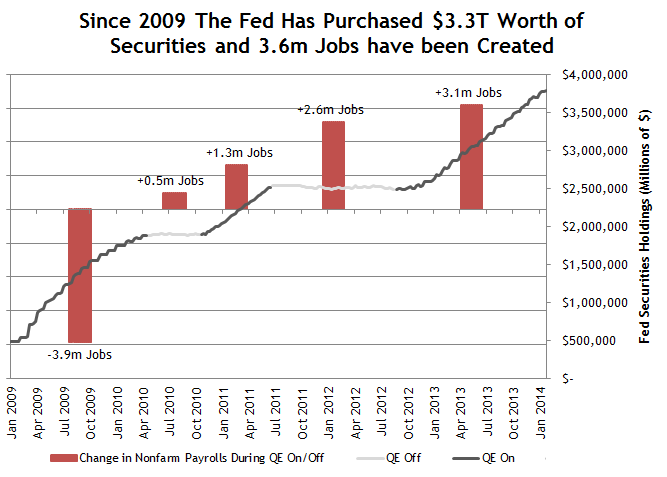Since 2009 the Fed has been purchasing bonds to help stimulate the economy. The purchases began at the depths of the financial crisis, and so originally these purchases were made with a focus on promoting financial stability.
In the last couple of years though, the reasoning behind the purchases has shifted more towards a focus on unemployment. QE3, which began in September of 2012, was almost wholly justified by a weak employment environment and it was only in December of that year that the Fed started to tie purchases explicitly to unemployment rate targets.
Promoting maximum employment is a noble cause (and legally part of the Fed’s mandate), but using the Fed to achieve this goal is not the best way get the job done. The theory behind QE and employment is that QE will stimulate the economy, and a stimulated economy will produce more jobs. This could work in a round about way, but it’s similar to trying to move a football by flooding a football field. Why not just kick the football? If the economy is faced with an unemployment problem, there are more direct ways to deal with it.
To put the issue in context, below is a chart of the number of jobs created during QE compared to the amount of money spent on Quantitative Easing. Over the last five years the Fed has purchased $3.3 Trillion worth of securities. From the bottom of the employment market, the economy has added 7.8 million jobs. In today’s congressional testimony, Janet Yellen estimated that QE may have been responsible for only about 1 million of the total 7.8 million job increase. If that’s the case then the QE price tag per job hits a staggering $3.3 million.
There are those who will argue that this is not a fair comparison to make, because the Fed hasn’t spent this money directly on jobs, but that’s the point. A similar number of jobs could have been created at a fraction of the cost by targeting spending more directly.
Even if the Fed had just capitalized a new company called “US Jobs, Inc.” it could have hired 1 million people and paid them $50 k per year for five years for $250 B dollars. The company could have done whatever the Fed wanted it to, and even if at the end of five years, the company had created no value whatsoever, the Fed could have written it off as a $250 B dollar loss. That’s 7.5% of $3.3 T. When interest rates rise, we should consider ourselves lucky if the Fed only takes a 7.5% loss on its (still growing) bond portfolio.
Disclosure: The information in this blog post represents my own opinions and does not contain a recommendation for any particular security or investment. I or my affiliates may hold positions or other interests in securities mentioned in the Blog, please see my Disclaimer page for my full disclaimer.

